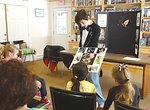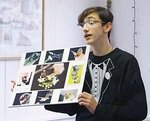ROCK HILL — Truth Muller's original goal for his Buddies for Bats project was to reach the ears of 200 people.
Now, after the four-year anniversary of his project's inception, Truth Muller has …
This item is available in full to subscribers.
Please log in to continue |




ROCK HILL — Truth Muller's original goal for his Buddies for Bats project was to reach the ears of 200 people.
Now, after the four-year anniversary of his project's inception, Truth Muller has achieved an incredible audience of 3.2 million people worldwide as he teaches about bats and bat conservation through Buddies for Bats. Not only did Truth Muller surpass his goal, he did so at the age of 15.
“When I was younger I remember there used to be a good amount of bats in Rock Hill,” stated Muller. “I knew nothing about bats, I just thought they were cool. Now there are no bats.”
A trip to the New York State Fair and information from the NYS Wildlife Service provided Muller with the answer to the disappearance of the bats he regularly saw around his home. A deadly fungus, called White Nose Syndrome, had decimated the bat population of New York and by 2011, 93 percent of the state's bats had been killed by the disease.
White Nose Syndrome is a bacterial fungus and appears to have originated at one of the caves at Howe Caverns in New York, most likely brought into the United States on the clothes of European spelunkers. After bats contract the bacteria they are woken up during their hibernation period in the winter and starve or freeze to death. Since 2006 when White Nose Syndrome first appeared, the fungus has spread across the east coast and has killed an estimated 6 million bats.
“I learned about disease, which causes bats to wake up during hibernation and it was so horrible learning that bats in Rock Hill had died from this,” said Muller as he explained what he discovered at the age of 11. “On the way home I began brainstorming.”
The result was a project Muller termed “Buddies for Bats,” a public outreach program. The purpose is to inform people not only about the devastating fungus but also to teach about the vital significance of bats in the planet's ecosystems, as they are one of the world's most important pollinators.
For the beginning of the project, he started small. With a simple information stand, built from broomsticks, umbrella stands and a card table duck-taped together, Muller visited schools, libraries and street fairs in an attempt to teach people about bats.
“What I try to do and always love doing is teaching young students. I find that sometimes adults can be harder to change their opinions, ‘convert them to the bat side' as I say,” Muller remarked. “I keep it simple and exciting and if they get interested in it, they can ask about it and try to get more people involved. Start the ripple effect.”
The “ripple effect” Muller began four years ago grew significantly after receiving a $1,000 grant from The Pollination Project which funds individuals who are working to make the world peaceful, just and more sustainable. The grant gave Muller both funding and publicity for his efforts toward bat conservation.
After articles about “Buddies for Bats” was published by the Huffington Post and on the White House website, the publicity caused people to come to Muller with opportunities to speak about the misunderstood species. Additionally, he was able to use the grant money to upgrade the flyers and information he was handing out that added a degree of professionalism, despite his young age.
“I am glad to help out in the best way I can. I have mainly traveled around New York State. I started the project here and it is one of the most important states to teach people that we need to protect bats,” said Muller. “I never imagined the project would go this far. It's really incredible.”
Muller has extended the reach of his program around the globe in countries such as Italy, Germany, the Philippines and Mexico. It even started a “Buddies for Bats” project in Croatia.
Muller is also currently the only member of Bat Conservation International's Speaker's Bureau in New York State as well as the youngest member in BCI's history. Bat Conservation International is an international organization founded in Texas in 1982 dedicated to preserving bats and their ecosystems to ensure the health of the planet.
Muller still continues to travel around New York State and local areas to further educate people on the importance of the flying mammal and eradicate any misconceptions, especially since White Nose Syndrome continues to spread across the country. The bat population's recovery is a long process but there is hope since the remaining bats appear to be immune to fungus.
“It's a long, tough road. There have been species of bats that went extinct during my project and two new species were discovered and I have been able to see these things change in real time,” Muller noted. “New York State is still recovering. I went seven years without seeing a single bat in the state. Things are still kind of bad but in 2014 I saw my first bat.
“I strongly feel it is vital we protect the bats that are left. Bats will always be on my mind and something I will always be invested in,” he added.
More information about Muller's project can be found on the Facebook page “Buddies for Bats.”
Key Bat Facts
• Bats are one of the world's greatest pollinators alongside birds, bees, and butterflies.
• If bats stop pollinating 500 plant species would disappear
• They are the only flying mammals and date back 60 million years
• Bats are unparalleled in pest control, eating thousands of bugs every night
• 1331 species of bats exist and new ones are still being discovered
• Less than 0.1 percent of all bat species will contract rabies, no more than any other animal species
Comments
No comments on this item Please log in to comment by clicking here